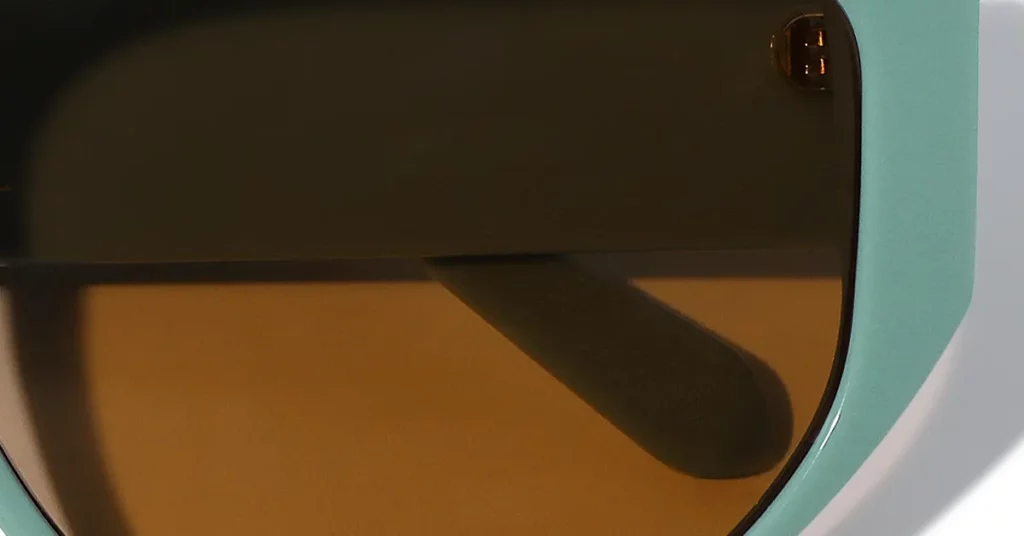As a brand manager or designer, you face the immense challenge of creating an eyewear collection that truly stands out. You know that story and quality are everything, but it’s hard to be unique when using the same materials as everyone else. This guide is your map to the world of artisanal acetate, exploring exclusive producers in France and the UK to help you build a powerful brand with materials that justify a premium price.
Artisanal acetate offers two distinct sourcing narratives. France is home to the last raw acetate sheet producer, Décoracet, enabling a “100% French Production” story. The UK excels in a “Designed in Britain, Crafted in Europe” model, where brands leverage premier European acetates to create unique collections, turning sourcing transparency into a brand strength.
The Strategic Imperative: Why Your Brand Must Look Beyond Mainstream Suppliers
Before we dive into specific producers, you need to understand the strategic value of looking beyond the usual suspects. In my two decades in this industry, I’ve seen countless brands struggle with the same fundamental problem. Making the conscious choice to source artisanal materials is the single most powerful step you can take to build a defensible brand from day one.
Escaping the Sea of Sameness: The Fear of Commodification
The fear that your collection will get lost in a crowded market is valid, and it’s a direct consequence of massive industry consolidation. When your competitors are all drawing from the same well, your product risks becoming a commodity, indistinguishable from the rest. The market is saturated with brands using the same dominant Italian and Chinese suppliers, creating a landscape where differentiation is incredibly difficult.
This “sea of sameness” is largely driven by a single conglomerate, EssilorLuxottica, which holds a staggering level of control. They own a massive portfolio of brands like Ray-Ban and Oakley and produce licensed eyewear for fashion houses like Chanel and Prada. This consolidation creates a bottleneck of material diversity, making it harder for new brands to find a unique voice.
Without a unique material story, your brand is forced to compete on design and price alone. Design can be imitated, and competing on price is a losing battle for a premium brand. An exclusive material creates a defensible advantage, with independent brands focused on craftsmanship seeing visibility increases of over 85%. This is why your choice of material is not just a component—it’s the foundation of your business.
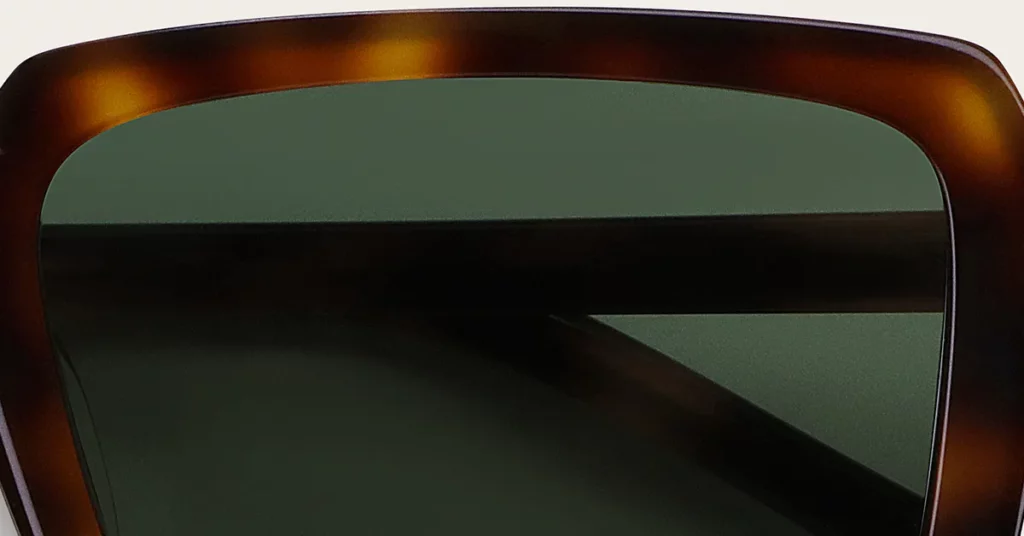
From Material to Legend: How an Artisanal Sourcing Story Justifies a Premium Price Point
Choosing an artisanal supplier is about more than a unique color; it’s about weaving a story of quality, heritage, and craftsmanship into your product. This narrative connects with customers on an emotional level, giving them a powerful reason to choose your brand and pay a premium for it. It is the most effective way for an emerging brand to compete on story, not just price.
Your material’s provenance, or the story of where it comes from, is a key asset. When you source acetate from a family-owned workshop in the French Jura mountains, your brand inherits their generations of expertise. Their history lends your product an immediate sense of authenticity. This allows you to attach your brand to a recognized heritage of craftsmanship.
Artisanal block acetate also offers the “no two alike” advantage. Because of the organic way the material is layered and sliced, the pattern on every frame is slightly different. You can tell customers they are buying a one-of-a-kind piece, creating a sense of exclusivity that mass-produced items can never replicate. This transforms the frame from a product into a personal artifact.
Best Practice: Your sourcing story is one of your most valuable marketing assets. On your product pages, instead of “Made from premium acetate,” write “Handcrafted from block acetate by Décoracet, the last remaining artisanal producer in the French Jura mountains.” With a majority of young consumers preferring sustainable brands [Forbes, 2024], your material’s journey is a direct path to their loyalty.
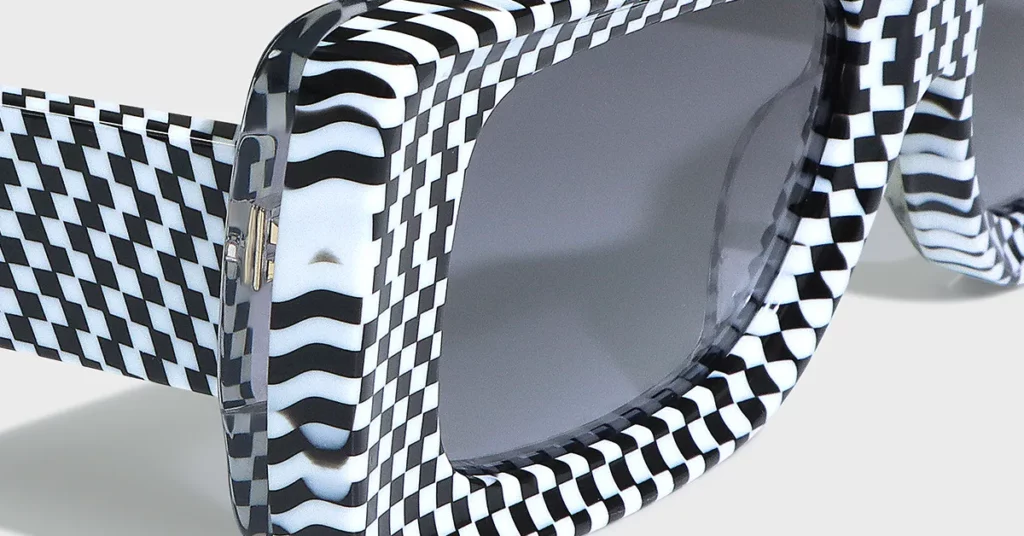
What Defines “Artisanal” Acetate? A 101 for Brand Leaders
To make smart sourcing decisions, you need to understand what makes artisanal acetate different. The term “handmade” is often used because the process requires a great deal of skilled handwork, from color mixing to final polishing. Let’s break down the key markers of quality that separate this premium material from its mass-market counterparts.
The Material Science of Exclusivity: Bio-Plastics and Their Brand Value
The value of premium acetate begins at the molecular level. Its natural origins are the source of its superior qualities and its powerful sustainability narrative, which are key differentiators for any modern premium brand. Its plant-based origin is what gives the material its signature warmth, depth of color, and luxurious feel.
Definition: Cellulose acetate is a bio-based plastic, meaning it is made from a renewable, plant-based source. It is a non-petroleum-based material derived from natural cotton fibers and wood pulp, making it fundamentally different from conventional plastics.
Simple Analogy: Think of it like the difference between a natural fabric like cotton and a synthetic one like polyester. Both can be used to make a shirt, but the cotton’s natural origin gives it a distinct breathability, texture, and feel against the skin. Premium acetate offers a similar tactile and qualitative advantage over its synthetic counterparts.
Because it comes from plants, high-quality acetate is also hypoallergenic. This is a critical feature for a product worn on the skin every day. The industry is also innovating with “bio-acetates,” where standard plasticizers are replaced with vegetable-origin solutions, making them even more environmentally friendly and providing a powerful marketing angle, as most shoppers now prefer sustainable brands.
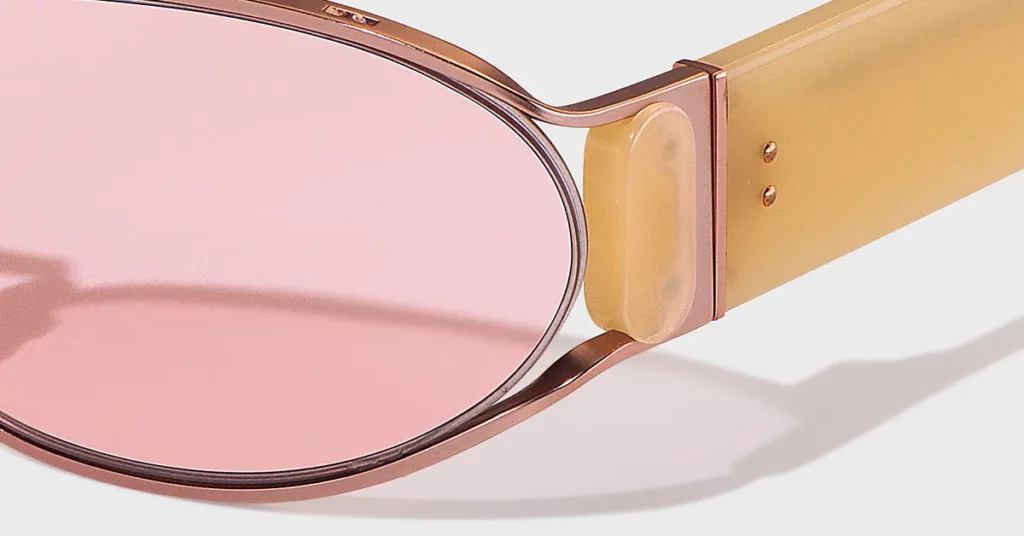
The Hallmarks of Handcraft: Block Casting vs. Mass-Market Injection Molding
The manufacturing method is one of the biggest differentiators between artisanal and mass-market frames. The slow process of block casting creates a richness that the speed of injection molding simply cannot replicate. This choice directly impacts the final look, feel, and exclusivity of your eyewear.
| Method | Block Casting (Artisanal) | Injection Molding (Mass-Market) |
| Process | Layers of colored acetate are fused into a solid block, cured, then sliced into sheets. | Liquid acetate is injected into a metal mold to quickly form frame components. |
| Color Depth | Rich, deep, and layered patterns that run through the entire material. | Color is often superficial, lacking complexity and looking like a printed surface. |
| Durability | Strong, stable, and allows for thicker, more sculptural designs. | Can be more brittle and has more limitations on frame shape and thickness. |
| Exclusivity | The organic process ensures no two frames are ever exactly alike. | Every frame produced from the mold is identical, creating a uniform product. |
Pro Tip: You can learn to spot the difference with a trained eye. Look at the edges of the frame or the temple tips. On a frame made from block acetate, you will see the pattern and layers continue all the way through the material, proving its depth and quality.
The Art of the Finish: Why Curing & Polishing Are Critical Quality Markers
The final stages of production—curing and polishing—are where a good frame becomes a great one. These steps are non-negotiable markers of true artisanal quality. In my years of handling materials, I can tell you that you can feel the difference instantly. Premium, well-cured acetate has a satisfying density and a pleasant warmth to the touch.
After acetate sheets are created, they must go through a long curing period, often lasting for weeks or months. This allows all solvents to fully evaporate, making the acetate stable, strong, and chemically inert. This science of stability is what prevents the material from warping or degrading over time.
Critical Warning: Inadequate curing is one of the biggest causes of poor-quality frames. If rushed, the material can degrade in a process known as “vinegar syndrome,” where it becomes brittle and emits a distinct vinegar smell. A supplier’s commitment to a proper, lengthy curing process is a direct indicator of their commitment to quality.
The deep, luxurious shine of a quality frame comes from a multi-day polishing process. Components are first tumbled for hours in barrels with wood chips, then meticulously polished by hand. This creates a deep glow from the material itself, unlike cheap frames that are just sprayed with a surface coating that can scratch or peel.
Finally, look inside the temples for a metal wire core. This component provides strength and allows an optician to adjust the temples for a perfect fit. In the finest frames, this core is transformed into a beautiful design detail with intricate, engraved patterns, turning a functional necessity into a hidden piece of art.
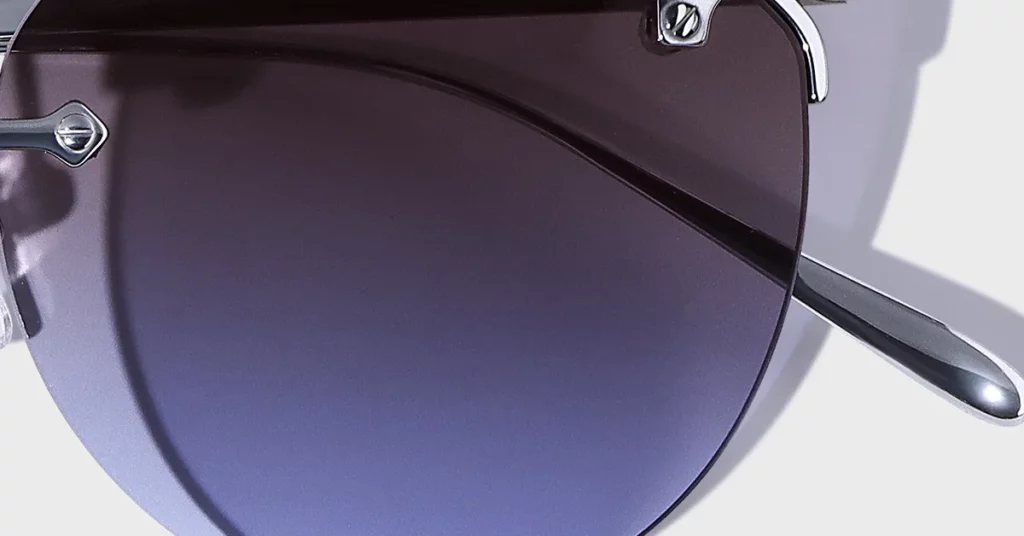
The French Artisanal Acetate Scene: A Deep Dive
France holds a legendary status in the world of luxury goods, and its eyewear is no exception. The country’s reputation is built on a deep history of craftsmanship, particularly centered in one specific region. For a brand seeking a narrative of authenticity, the French scene offers a unique and powerful opportunity.
The Jura Legacy: Oyonnax, the Historic Heart of French Eyewear
The story of French eyewear is linked to the Jura mountains, where the town of Oyonnax, often called “Plastics Valley,” became the cradle of the industry. The region’s expertise began centuries ago with horn combs, and these skills were later adapted to early plastics. This evolution from traditional crafts to modern “haute lunnetterie” (high-end eyewear) is a rich history you can tap into.
The “Made in France” appellation is a globally recognized symbol of quality and luxury. For your brand, this label acts as a powerful marketing tool, instantly communicating a standard of excellence and justifying a premium position in the market. When you partner with a supplier from Oyonnax, you are not just buying a component; you are inheriting a story of multi-generational craftsmanship.
Supplier Spotlight: Décoracet – The Last Remaining French Acetate Producer
At the heart of the French scene is a single, pivotal supplier. For brands seeking the ultimate “100% French” story, from the raw material to the final frame, all roads lead to Décoracet. They are, quite simply, the only producer of cellulose acetate sheets left in France.
Located in Oyonnax, Décoracet’s roots trace back to one of the region’s oldest companies, founded in 1830. The modern company was formed in 1993 and has since become the largest acetate producer in France. Their story as the “last bastion” of French production is an incredibly powerful and exclusive narrative for a partner brand.
Beyond standard block acetate, Décoracet possesses a unique capability: bespoke embeddings. They can embed materials like delicate skeleton leaves, fine French lace, or shimmering metallic flakes between two layers of crystal-clear acetate. This technique offers a level of customization and artistry that is virtually impossible to find elsewhere. Partnering with them gives your brand a claim that very few others can make.
From Sheet to Frame: Notable French Ateliers for Production Partnerships
Once you have your unique acetate sheets, you need a skilled partner to transform them into finished frames. The Jura region is home to numerous ateliers. Ateliers Baudin, for example, represents the height of bespoke luxury, specializing in fully custom, handmade eyewear from premium acetate and natural horn. They are ideal for a brand positioning itself in the realm of pure, made-to-measure luxury.
Another notable partner is Traction Productions. With a history in Oyonnax dating back to 1872, they offer a different flavor of French craftsmanship. Their design philosophy blends Californian modernity with French refinement, resulting in bold, artistic frames. They are an ideal partner for a fashion-forward brand that wants to create statement pieces backed by an incredible heritage story.
Pro Tip: When you approach a French atelier, being prepared is key. Go into the conversation ready to ask specific questions to show you are a serious partner:
- What are your minimum order quantities (MOQs) for a new design?
- Can you work with acetate sheets supplied directly from Décoracet?
- What are your capabilities for custom hardware, like hinges and wire cores?
- What is your typical lead time for samples and for a full production run?

The British Artisanal Acetate Approach: A Guide to Sourcing
The United Kingdom has a vibrant independent eyewear scene, but it operates on a different model than France. The UK’s power lies not in raw material production, but in design, curation, and transparent storytelling. Understanding this distinction is key to leveraging the unique strengths of British-based brands and designers.
The “British Design, European Materials” Narrative: A Powerful Angle for Emerging Brands
The core of the British approach is a narrative that celebrates local design ingenuity while embracing the best of European material craftsmanship. This transparent story resonates strongly with modern consumers who value quality and authenticity. The reality is that the UK lacks any large-scale producers of raw cellulose acetate sheets. Virtually all high-quality acetate used by British brands is imported, primarily from Italy.
This is not a weakness; it is a strategic opportunity. By being open about the sourcing process, a British brand can position itself as an expert curator. The story becomes one of searching Europe for the finest materials and bringing them back to a UK workshop to be transformed with a distinct British design sensibility. This transparency builds immense trust.
The key is to make this story a central part of your brand communication. Don’t hide your sourcing; celebrate it. Use specific, evocative language like: “Every frame is born in our London studio. To bring our designs to life, we partner with a family-owned workshop in the Italian Alps that has been working with world-renowned Mazzucchelli acetate for over three generations.”
Sourcing Spotlight: Leading UK Artisanal Brands & Their Approach
To see this strategy in action, you only need to look at some of the UK’s most respected independent brands. Banton Frameworks, based in Glasgow, is the archetype of the small, truly artisanal UK producer. They explicitly state that they use “Europe’s finest acetate” and then design and craft every single frame in-house, making their British craftsmanship the core of their story.
Cubitts, a certified B Corp founded in London, demonstrates how this model can be scaled. They are transparent about using the “finest Mazzucchelli acetate” from Italy [Cubitts, 2024], which is then used to create collections handcrafted in their UK workshop. Cubitts proves that a brand can grow while maintaining its commitment to material quality and a strong British identity.
Kirk & Kirk offers a fascinating hybrid model. This UK-based design house sources a unique, custom-made acrylic material from Italy, then has their frames meticulously handmade in France for the highest level of finishing [Kirk & Kirk, 2025]. Their story shows a “British brand” can be a global collaboration, with the UK as the creative hub directing the best artisans in Europe.

The Emerging Brand’s Playbook: How to Vet and Partner with an Artisanal Producer
Now that you understand the “why” and the “what,” it’s time for the “how.” Approaching an artisanal producer can feel intimidating, but with the right preparation, you can present yourself as a professional partner. This playbook will walk you through the essential steps, from initial research to your first sample order.
Your Pre-Flight Checklist: What to Prepare Before Making First Contact
Remember This: Artisanal producers are often small, passionate businesses. They want to work with brands that are organized, professional, and share their respect for the craft. Doing your homework before you reach out is the single best way to make a positive first impression.
- Define Your Core Material Story: Decide first if you are building a “100% French Production” brand or a “Curator of Europe’s Finest Materials” brand. This vision will determine which type of supplier is the right fit.
- Create a Technical Specification Sheet: You need a professional “tech pack.” This blueprint for your product must include clear, scaled drawings; key measurements like lens width and bridge width; and specific material and component callouts.
- Establish Your Budget and MOQs: Be realistic about your target cost of goods sold (COGS) and be prepared to discuss Minimum Order Quantities (MOQs). Knowing your financial limits ahead of time will make conversations much more productive.
- Prepare a Professional Brand Deck: A simple presentation covering your brand vision, target customer, and designs shows you are a serious partner. Briefly explain why you believe their specific skills are perfect for your vision.
The Art of the Dialogue: Key Questions to Ask a Potential Acetate Supplier
Once you make contact, your goal is to vet the supplier for quality, reliability, and collaborative fit. These five questions will give you the critical information you need to make a confident decision.
- “Can you tell me about the origin of your cellulose?” This opens a conversation about their commitment to sustainability and responsible manufacturing.
- “What is your typical curing time for new blocks?” A producer who proudly details their multi-week curing process is one who prioritizes quality and material stability.
- “What are your capabilities for creating bespoke colors or patterns?” This helps you understand their level of artistry and willingness to collaborate on custom work.
- “What are your MOQs and lead times for custom runs?” This is the essential business question to determine if they are a logistical fit for your business plan.
- “Which brands have you worked with that share our aesthetic?” Asked respectfully, this helps gauge their experience with brands in your market segment.
From Samples to Production: A Step-by-Step Guide to Collaboration
Once you’ve chosen a partner, the final phase begins. This process follows a clear, logical progression from sampling to shipping.
- First, request material samples. Before committing, always get your hands on the actual acetate. Feel its weight and density and hold it to the light to check the color depth and transparency.
- Second, commission a prototype. Never go directly from a drawing to a full production run. A prototype is a crucial step to test the final look and feel of your design and the manufacturer’s ability to execute it perfectly.
- Third, negotiate terms. Once the prototype is approved, you will discuss pricing, MOQs, and the payment structure. A common arrangement is 50% of the total cost upfront to cover materials, with the final 50% due upon completion.
- Finally, navigate logistics. You will need to coordinate shipping from the European factory to your location. Remember to factor in the costs of international shipping, insurance, and any applicable import duties or taxes into your final cost of goods.
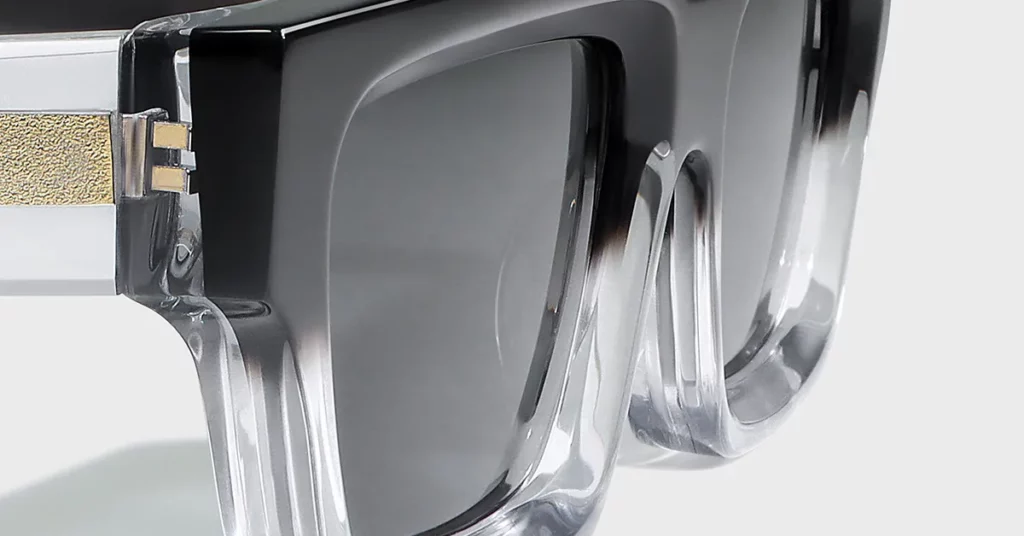
Conclusion
Your journey into artisanal acetate is about making a foundational decision that will define your brand’s identity, justify its price, and create a lasting customer connection. By choosing this path, you compete on story and substance, not just style and price. This is how you build a brand that endures, with a tangible quality your customers can feel and a narrative they can believe in.
Frequently Asked Questions
1. What is the main difference between Italian and French acetate?
The primary difference is scale and focus. Italy is home to large producers like Mazzucchelli who supply many top brands from a vast catalog. France’s scene is more niche, centered on Décoracet, who offers a unique “100% French” story and bespoke capabilities like material embeddings.
2. Is it more expensive to use an artisanal acetate producer?
Yes, the per-unit cost is typically higher than for mass-produced alternatives. You should view this not as an expense, but as an investment. This investment in superior quality, unique materials, and a compelling story is what enables you to command a premium retail price.
3. How do I get samples from a producer like Décoracet?
You get samples by approaching them professionally. Prepare your brand introduction deck and technical specifications, then reach out with a clear, respectful request. Artisans are eager to partner with creative brands that have a clear vision and have done their homework.
4. Can I claim my frames are “Made in the UK” if I use French acetate?
While labeling laws have specific rules, you can tell a more compelling story. A powerful narrative would be “Designed in London, handcrafted from artisanal French acetate.” This communicates both your design identity and your commitment to sourcing the best possible materials.
5. What is the average lead time for a custom batch of artisanal acetate?
Lead times can vary, but you should plan for several months, not weeks. The process, from custom color development to curing and slicing, is slow and deliberate. Artisanal production is the opposite of fast fashion, so build longer timelines into your production calendar.

